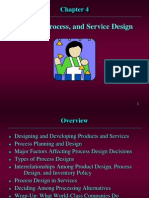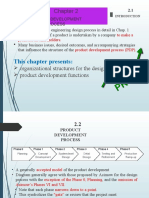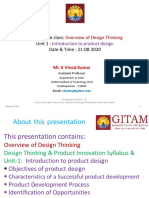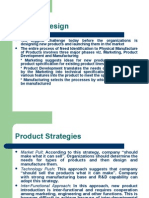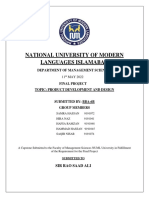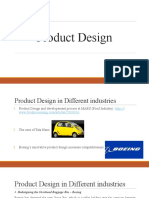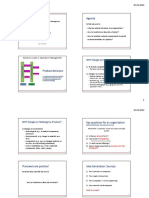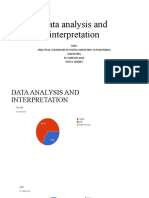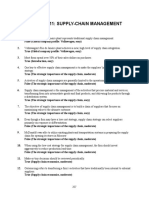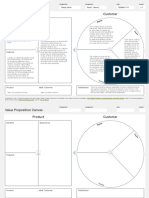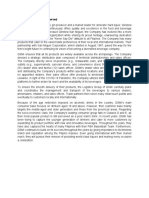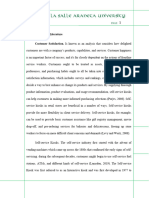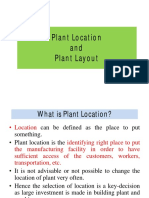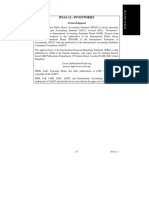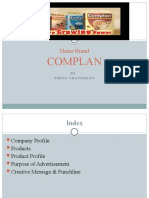Created by Turbolearn AI
Textile Design Procedure
Evolution of Textile Design
Early textile design relied heavily on empirical skills, practical knowledge, and trial
and error. Design was largely based on experience and intuition. While scientific
understanding of fibers and textiles grew tremendously, design methods remained
largely empirical. This contrasts with other engineering fields where the
development of science and mechanics allowed for quantitative predictions, leading
to changes in design procedures. Textile design lagged in adopting these
advancements.
Empirical: Based on observation or experience rather than theory or
experiment.
This lag might be attributed to two factors:
Low Risk and Cost: Most daily textile products pose minimal risk of failure and
are inexpensive. This reduced pressure on designers to ensure product success,
especially in applications where life-threatening failures were not a concern.
Lack of Documented Methodology: A documented design methodology
specifically for textile engineers was missing.
The Changing Landscape of Textile Design
Several factors are driving a shift in textile design culture:
Computer-Aided Design (CAD): The widespread use of computers allows for
simulation software to visualize designs before production.
Fiber Diversity: The availability of a wide variety of synthetic fibers, in addition
to natural fibers, expands design possibilities.
Expanding Applications: Textiles are increasingly used in demanding
applications (technical textiles) such as:
Civil Engineering
Mechanical Engineering
Biomedical Engineering
Agriculture
Page 1
� Created by Turbolearn AI
This necessitates a more rigorous engineering design approach to meet the
performance requirements of these diverse applications.
Generic Product Development Steps
The following steps apply broadly to product development, including textile design:
1. Planning: Initial planning is crucial for any project. Management approval is
needed before proceeding.
2. Concept Development: Once the plan is approved, the design team develops
various concepts for the product.
3. Concept Review: The team reviews and discusses the proposed concepts.
4. Design: This stage involves two parts:
Broad Design: Defining overall parameters, components, and
specifications.
Detailing: Refining the design based on the broad design parameters.
Product Design Process
Product Design Stages
The product design process can be broken down into several key stages:
Page 2
� Created by Turbolearn AI
Broad Design: Defining the overall parameters and specifications of the
product.
Detailed Design: Fleshing out the specifics of each component.
Specification Review: A critical review to catch errors and oversights. This
stage ensures that specifications are frozen temporarily.
Prototype Development: Building a prototype to test functionality and
performance. This stage involves a fabrication process.
Critical Design Review: Reviewing the prototype to evaluate its performance
and appearance against the design specifications.
Testing: Conducting laboratory and field trials to assess product performance.
Refinement: Improving the design or specifications based on test results.
Production Approval: Obtaining approval from top management for large-
scale production. This is crucial because a failed product can seriously damage
a company’s reputation.
Production: Manufacturing the product on a large scale.
Sales: Marketing and selling the finished product.
The review process is repeated at multiple stages to identify and correct
potential issues early on, minimizing the risk of costly mistakes.
Spiral Product Development
This iterative approach emphasizes continuous testing and refinement:
1. The initial stages (broad design, detailed design, build, and test) are the same
as in the linear process.
2. If the product's performance doesn't meet expectations after testing, the design
is revisited. This iterative process continues until the desired performance is
achieved.
3. This iterative cycle includes revisiting detailed design aspects (e.g., component
selection, material improvement) followed by building a new prototype and
retesting.
4. Once the product's performance meets expectations, top management approval
is sought for commercial production.
Complex System Design
This approach is particularly useful for complex products with numerous
components:
Page 3
� Created by Turbolearn AI
1. The initial stages (broad design, detailed design, build, and test) are the same
as before.
2. The broad design is split into several sub-designs (e.g., design of part A, design
of part B, etc.)
3. Each sub-design is worked on by a separate team, tested, and checked for
performance.
4. Once all sub-designs meet expectations, they're integrated into the complete
product.
5. The complete product undergoes final testing.
6. After successful testing, top management approval is required before
production begins.
This method is especially relevant for products like airplanes or cars,
which comprise many diverse components. A space suit is another
example of a complex product requiring expertise across multiple
disciplines, including textiles engineering and various other fields.
Planning Phase: Identifying Opportunities
The first step in any product design process is planning, which begins with
identifying opportunities:
Opportunity Identification: Assessing the market to determine if there's
demand for a new product. In a commercial setting, this assessment is crucial to
ensure profitability and market success. Companies only invest in designing
new products when they foresee a market for those products and the potential
to earn a profit.
Lecture Notes: Product Planning
Identifying Opportunities
The first step in product planning is identifying opportunities. This involves
generating ideas for new products or features for existing ones.
Sources of Ideas:
Page 4
� Created by Turbolearn AI
Marketing and sales personnel (direct customer interaction)
Research organizations (e.g., CSIR labs, university research departments)
Current or potential customers, suppliers, and business partners
Documented customer frustrations and complaints
Understanding customer dissatisfaction is crucial for identifying areas for
product improvement or new feature development. This includes
addressing specific complaints and unmet needs.
Changes in lifestyles and demographics:
Shifts in consumer preferences due to evolving lifestyles and
population demographics (e.g., age distribution) influence product
demand.
Competitor analysis: Studying competitor products can reveal opportunities for
improvement or differentiation.
Tracking emerging technologies: Monitoring technological advancements can
lead to the development of superior products.
Evaluating and Prioritizing Projects
Once opportunities are identified, projects need to be evaluated and prioritized. This
evaluation should consider the company's competitive strategy, market
segmentation, and technological trajectories.
Competitive Strategies:
Strategy Type Description
Technological Focuses on utilizing new technologies for product development
Leadership and maintaining a technological edge.
Aims to offer products with superior value for money through
Cost Leadership
efficient manufacturing and cost optimization.
Prioritizes understanding and meeting the changing needs and
Customer Focus
preferences of customers.
Involves identifying successful products in the market and
Imitative
quickly launching similar products to minimize risk.
Market Segmentation:
Page 5
� Created by Turbolearn AI
Customers can be segmented by:
Age (children, youth, middle-aged, elderly)
Income (low, middle, high)
Region (geographic location)
Technological Trajectories:
The performance of a new technology often follows an "S-curve" pattern.
Initially, performance is low, then it rapidly increases before reaching
maturity and potentially becoming obsolete.
The "S-curve" indicates that:
Early adoption of emerging technologies can provide a significant performance
advantage.
Continuing with a mature technology may not yield further substantial
performance improvements.
Product Development Planning
Product Improvement & Market Capture
Rapid product improvement is key to capturing market share.
However, this must be balanced against the risk of increased competition and
reduced profitability as more players enter the market.
Resource Allocation & Launch Timing
Budgeting: Carefully plan and allocate resources (manpower, materials,
fabrication costs). Determine the total cost of development in advance.
Launch Timing:
Introduce products quickly, but never compromise quality.
Avoid frustrating customers by releasing too many improvements too
rapidly. The example of the rapid turnover of mobile phone models was
given. Customers may feel cheated if their expensive purchase quickly
becomes obsolete.
Conversely, releasing too late can cause the company to lag behind
competitors. The need to find a balance was highlighted.
Page 6
� Created by Turbolearn AI
Project Statement
The project statement should include:
Title: A concise and descriptive title for the project.
Target Market: Clearly define the intended customer base.
Key Business Goals: Specify goals related to cost, quality, financial
performance, and/or market share.
Product Description: Provide a general overview, highlighting customer
benefits.
Example: A project statement might describe the development of a new
product, specifying its target market, business goals, and the benefits for
customers.
Assumptions & Constraints
Consider these factors when planning a project:
Customer Service: If crucial, specify service requirements and provide clear
maintenance instructions (e.g., instruction manuals).
Environmental Sustainability: Incorporate sustainability considerations into the
product's design. This is increasingly important and can be a key selling point.
Manufacturing: Ensure that existing production systems can handle the new
product, considering factors such as technology and production capacity.
Example Project Statement: Comfort Denim
Page 7
� Created by Turbolearn AI
Aspect Description
Product Title Development of a Comfort Denim
Product
Lightweight, stretchable, quick-dry denim
Description
Key Business Retain leadership in the denim business; capture 50% of sales in
Goals the primary market.
Primary Market Casual wear for young techies and university students
Product On or before a specified date (e.g., September, to coincide with
Introduction upcoming festivals)
Secondary Handbags, jackets, and other potential products using the same
Market denim fabric
Assumptions Steady supply of raw materials
Need to import certain raw materials (e.g., cotton, lycra), which
Constraints
presents potential logistical challenges.
Lecture Notes: Product Design Planning
Time Lag and Dependencies
Time lag is a constant factor in product development. The availability of
resources can fluctuate.
Dependencies on other countries or factors can impact timelines and
availability.
Stakeholders in Product Design
The following are stakeholders in product design:
Young customers
Production engineers
Distributors
Retailers
Shareholders
Defining Product Design Steps and Planning
Page 8
� Created by Turbolearn AI
The lecture covered the various design steps involved in product
development and the importance of thorough planning. Proactive
planning minimizes the risk of encountering unforeseen issues later in the
development process (e.g., six months into a project). Careful planning
helps avoid costly setbacks.
The Importance of Planning
A well-defined planning activity is crucial. By carefully considering all
aspects upfront, the likelihood of problems arising later is significantly
reduced.
Page 9





